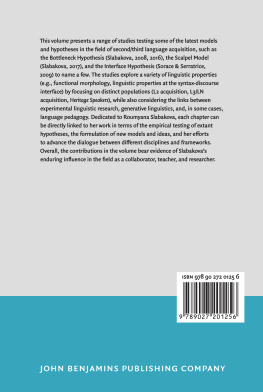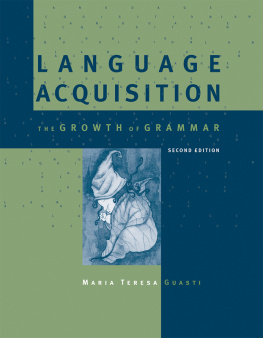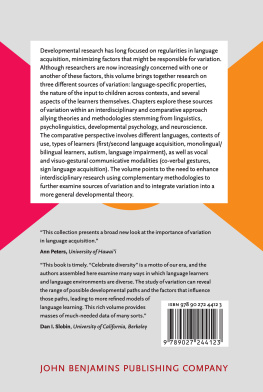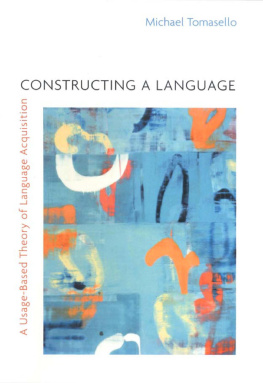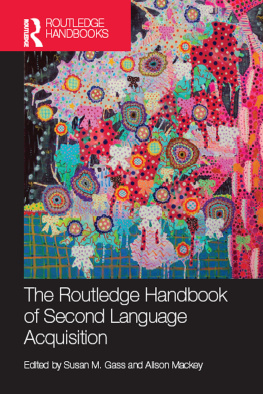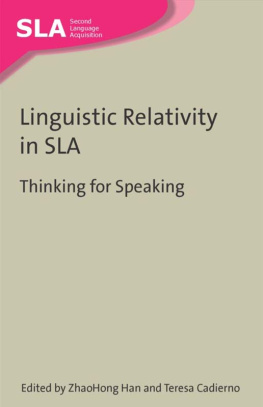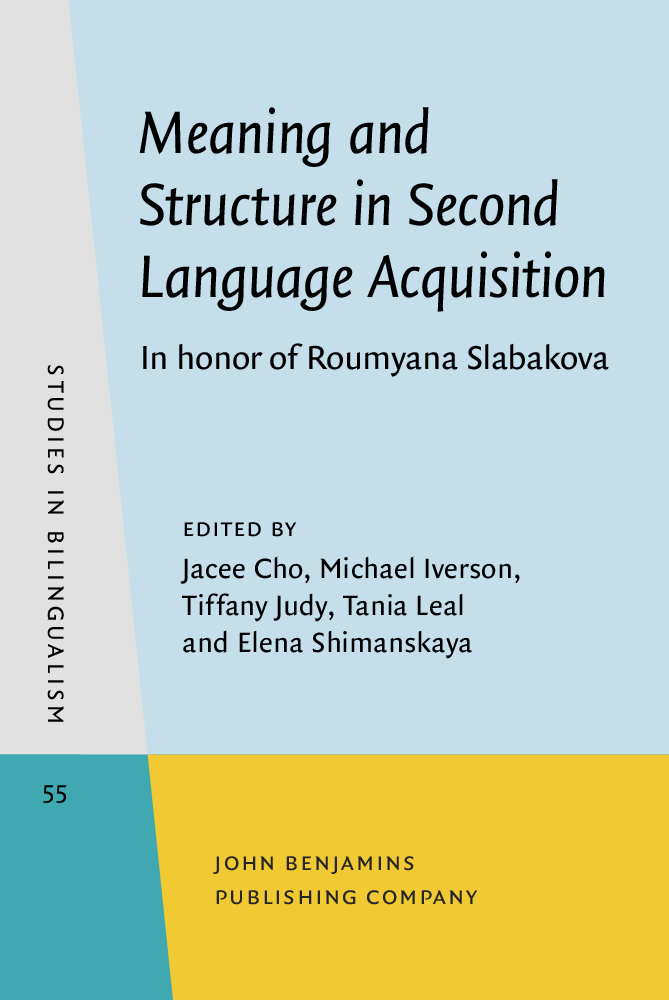

Jacee Cho Michael Iverson Tiffany Judy Tania Leal Elena Shimanskaya
doi: 10.1075/sibil.55
ISBN: (ebook)
John Benjamins Publishing Company https://benjamins.com
John Benjamins Publishing Company
Amsterdam/Philadelphia
Acknowledgments
The editors of the volume would like to thank the reviewers, listed below, for their valuable time and expertise. Their conscientious feedback and suggestions were essential to the volume.
Irma Alarcn, Tanja Angelovska, Kathleen Bardovi-Harlig, Anna Bartra Kaufmann, Alyona Belikova, Bryan Donaldson, Ylva Falk, Mara del Pilar Garca Mayo, Kook-Hee Gil, Jorge Gonzlez, Julia Herschensohn, Bradley Hoot, Tania Ionin, Tanja Kupisch, Luis Lpez, Junkal Gutierrez Mangado, Heather Marsden, Kate Miller, Roksolana Mykhaylyk, Diego Pascual y Cabo, Tom Rankin, Claire Renaud, Ghisseh Sarko, Irina Sekerina, Neal Snape, David Stringer, Jacopo Torregrossa, Julio Torres, Melinda Whong, Marit Westergaard
Finally, we owe our gratitude to the series editors, Jason Rothman and Ludovica Serratrice, for their support.
Introduction Jacee Cho, Michael Iverson, Tiffany Judy, Tania Leal & Elena Shimanskaya
In honor of Dr. Roumyana Slabakova and her significant and wide-ranging research in the field of language acquisition, this volume brings together a collection of articles by scholars whose research has been influenced by her work through collaboration, mentoring, or shared research interests. Like Slabakovas own prolific research agenda, the volume covers a range of related language acquisition phenomena, from second language (L2) acquisition of functional morphology and its meaning to the acquisition of linguistic properties at the syntax-discourse interface, from L3 acquisition of morphosyntax to the pedagogical implications of second language acquisition (SLA) research. Together, these chapters highlight the breadth and depth of Slabakovas research within the generative paradigm, while emphasizing her contributions to both the study of language acquisition in general and the description and understanding of the linguistic nature of the bi- and multi-lingual mind. This range is representative of Slabakovas substantial impact on the field of language acquisition. Her studies of acquisition of functional morphology in L2 learners, for instance, now serve as an essential starting point for new studies in formal SLA that investigate what learners come to know about the grammar of their second language at different developmental stages. The field of generative SLA is also indebted to Slabakova for her careful testing of various models and hypotheses; she has extended and detailed existing theoretical proposals and formulated new hypotheses and models to account for the empirically attested patterns of acquisition, such as the Bottleneck Hypothesis and the Scalpel Model, both of which are the focus of several of chapters in this volume.
The first section is comprised of four chapters on second language acquisition, arguably the subfield that has most benefited from Slabakovas research. The first chapter, written by Cho, examines L1 influence on L2 morphological development via L2 acquisition of scopal specificity in Russian by L1-English and L1-Korean speakers. Her experimental study examines how proficiency interacts with the morphological congruency effect (the presence or absence of the target morpheme in the learners L1) in L2 offline performance. While previous studies have shown that the presence or absence of the target morpheme is a deterministic factor and that proficiency plays little role in L2 online comprehension of functional morphology, in her study, proficiency showed itself to be a more influential factor in L2 offline comprehension than the morphological congruency effect. In sum, Chos chapter highlights the complex nature of L2 morphological development and points to the fruitfulness of researching mismatches between online and offline performance in the domain of L2 functional morphology.
The second chapter expands work across several studies carried out by Slabakova and her colleagues focusing on L2 knowledge that lies at the intersection of two linguistic modules (e.g. syntax-discourse or syntax-pragmatics). Leals chapter sets out to explore whether external interface properties (i.e. those requiring integration of grammatical and non-linguistic information, such as discourse) are particularly difficult or even unacquirable in L2 via examination of L2 acquisition of clitic left-dislocated structures in L2 Spanish. Leals chapter contributes to our knowledge of the topic by extending the focus from main clause clitic dislocations to embedded clauses. The study used an audio-visual acceptability task where Anglophone L2 participants rated sentences presented both visually and aurally on a continuum from Normal to Very strange in the provided context. Results from the study demonstrate that clitic left dislocations in embedded clauses are indeed acquirable by L2 learners of intermediate and advanced proficiency. Moreover, it appears that quality of input, operationalized in Leals study as length of study abroad, positively contributes to learners success in acquiring the structure. These results are largely compatible with previous findings from studies of interface phenomena conducted by Slabakova and her colleagues.
Next, Shimanskayas chapter reports on L2 acquisition of French object pronouns by Anglophone learners. While most previous research has focused on L2 acquisition of the syntax of object clitics in French and Spanish, Shimanskayas study brings to light the issues related to L1-L2 mismatches in lexical realization of morphosyntactic features in English and French. More precisely, the experiment examined the knowledge of grammatical case and argument structure and how this knowledge interacts with the knowledge of French object pronouns (both direct object clitics and strong pronouns, which are complements of prepositions) in the interlanguage of L1-English, L2-French learners. The results of the study indicate that argument structure distinctions responsible for the clitic/strong status of a pronoun represent a considerable hurdle on the path to target-like knowledge of these forms. In other words, the association between lexical encoding of grammatical case and argument structure, on the one hand, and the use of pronouns, on the other hand, appears to pose as much, if not more, difficulty for Anglophone L2 learners of French as the L2 acquisition of syntactic properties of French clitics.
Finally, Dekydtspotter, Black, Frimu, and Panwitz examine the role of processing load in anaphora resolution in L1-English, L2-French by focusing on animacy in the interpretation of the following pronouns: lui/elle 3 p.sing.masc/fem , le/la 3 p.sing.masc/fem.acc and son 3 p.sing.gen. The experimental data obtained in the study indicate that the processing of lui/elle vs. son (nominative/accusative vs. genitive, respectively) in conceptual structure engages animacy at distinct levels, reflecting lexical selection. It also shows that lexically-defined interface representations are privileged. Based on these findings, the researchers propose the Privileged Interface Representations Hypothesis (PIRH), according to which L2 comprehension might have less depth in the Conceptual-Intentional (CI) system beyond what is strictly grammatically necessary at the Logical Form (LF) interface.

